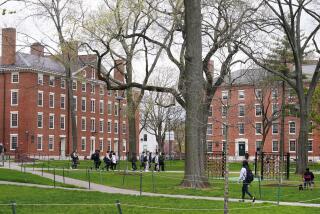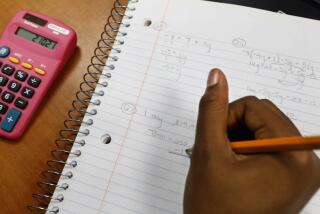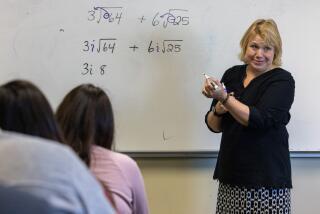Trying to Solve Math Problems
- Share via
* I have retired from 40 years of teaching high school, university and, primarily, community college, in the areas of math and physics.
The article “For Students, Math Equals Fear,” March 15, was well- researched and written, with one caveat.
You wrote, “More than a quarter of high school math classes are taught by teachers who are not credentialed in the subject.” True, but the whole story is even more frightening and egregious.
In California a teacher can be credentialed to teach math without having an academic subject major in math, and half don’t!
DEVON SHOWLEY
Cypress
* I am a 32-year-old woman who recently went back to school at a community college. I am not a C student as your article implies.
I do, however, think the problems in math today are caused by the growing use of calculators in high schools.
In college today they try to teach math without the use of calculators. Therefore, students start to have more anxiety and get confused.
I think if we stopped the use of calculators in our high schools we would have a lot more college students understanding math.
TONYA COLLIER
Orange
* Regarding the reform plan that might require students to take more math and do make-up work the summer before freshman year of college (March 17):
Students need more discipline in senior year of high school. From freshman year to junior year, many students take all the classes necessary to have a fun, worry-free senior year.
Most seniors take enough electives to pass instead of taking additional classes that would help them in preparation for college. I believe that teachers and parents should get involved with the class choices students make.
I remember asking a teacher why schools allow us to take nonsense classes, such as ceramics, for credit if that’s not what colleges are looking for. All he could answer was that it is our choice.
ADRIANA FERRARI
Fountain Valley
* With regard to your March 15 article, “For Students, Math Equals Fear,” I would bet that if the math exams were given to the general population, the results would be the same.
Or if the general population were to go to high school today, the same percentage would flunk math.
As a tutor in high school, I find that practically none of the students know how to add, subtract, multiply or divide, and they’ve never learned their multiplication tables. It’s easier to use a calculator.
The algebra and trigonometry books are so complex that only the best students can really understand them. The word problems are written so that you have to have completely mastered the English language to understand the problems.
It may be that I’m getting too old for the new math, but when I was in school in the 1930s we were taught the basic processes in a simple step-by-step form.
When I graded calculus papers as a reader in college, students were graded on how they went through the process, not just on the final answer (as in the SAT). Give me the good old days.
HOWARD NIEDERMAN
San Clemente
* I believe the issue of “math phobia” may be related to an article in the same edition of The Times, “Keys to Success.”
It shouldn’t surprise us that our older students are experiencing difficulty in math; after all, these are the very students who suffered through the wholesale dismantling of school music programs in the 1980s and ‘90s.
Study after study confirms the importance of music in fostering children’s intellectual development. Perhaps someday we will listen to the scientific evidence and restore music programs in our public schools.
S. JORDON
Lake Forest
More to Read
Sign up for Essential California
The most important California stories and recommendations in your inbox every morning.
You may occasionally receive promotional content from the Los Angeles Times.










